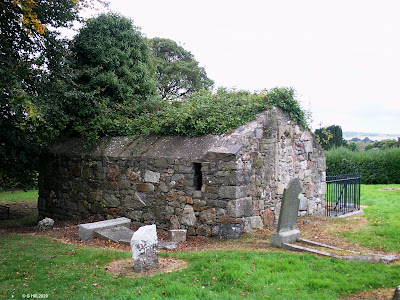A guide to the best and sometimes off the beaten track historical ruins around Ireland and how to get there.
Thursday, 7 May 2020
Old St Fintan's Chapel Sutton Co Dublin
Above Image: Entry gate and keeper's cottage ruin
Above Image: Bellingham family plot.
Above Image: West gable door
St.Fintan was a 6th century monk later canonized and was associated with the important monastic site of Clonenagh. It is still unsure how his association with Sutton came about. The fact that the name Sutton is derived from Gaelic "Sui Fhiontain" which translates to The Seat of Fintan would indicate some relationship with him in some form or other. To locals the old graveyard at Sutton is the resting place of Fintan and the small church was a shrine to him bearing his remains when they were transferred to Sutton when Clonenagh ceased to be in the 12th century. The little church is thought to date to the ninth century leaving the idea of it being too early a construct to be a shrine still shrouded in mystery. There is a non-extant holy well named after him not to far from the graveyard and the new church also bears his name. So one would assume that he had some connection with the area.
The chapel ruin was probably used later as a local place of worship and at approx 16' x 8' in size must be one of the smallest chapels in the country, but I believe the little church of St Benan on Inishmore in the Aran Islands is thought to be the littlest at approx 12' x 7' in size.
When I visited St Fintan's I found the chapel at the West end of the old graveyard. There is the ruin of an old keeper's cottage at the entrance gate. The East window of the chapel is bricked up leaving only two small windows in parallel with each other on the North and South walls. The doorway is in the West wall and is gated and locked and the interior looks quite overgrown. On my visit the small belfry on the West wall was covered in ivy and so is what remains of the roof. I Believe the walls slant up at an angle but the apex of the roof is missing being replaced by a metal grill. This too is overgrown at the moment. The belfry mentioned was a later addition to the chapel giving more evidence of it being used as a small place of worship. At its North wall a fenced area has been erected to contain the graves of members of the Bellingham family.
When the chapel fell into ruin is unclear but there is a print in the National Library by Eward McFarland from 1853 depicting the chapel as ruinous.
To find the ruin take the R105 towards Howth and turn right at Sutton Cross onto Greenfield Road. It is signposted as the scenic route. After approx 900m the name of the road changes to Carrickbrennan Rd. Continue for another 800m and you will see the new cemetery on your right. The old graveyard entry gate is just beyond this. You can park at the wall of the new cemetery.
Subscribe to:
Post Comments (Atom)






No comments:
Post a Comment